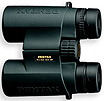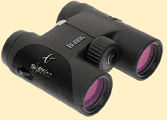|
Three 8x32mm Binoculars By Rick Ryals A hunting binocular requires several characteristics.� First, it needs to be light and small enough that it will be carried into the woods, and not left in the truck.� Second, it needs to be durable enough that the inevitable bumps and knocks won't break it.� Third, it needs to be water proof and fog proof since rain and cold is an unavoidable part of hunting.� Finally, the optical quality needs to be good enough to distinguish a deer from a rock or bush and antlers from twigs or branches. These three binoculars all meet these requirements to a greater or lesser degree.� The 8x32 size is ideal for hunting use.� It� is an excellent compromise between the binocular's size and weight and the lens diameter necessary for decent optical performance.� It also has sufficient size and mass to facilitate a steady hold. All of the models discussed here are well built and armored for shock resistance.� They are also roof prism models that have been sealed to be water and fog proof.� The prisms used in all models are BaK4 type with high resolution phase coating.� All lens surfaces are fully multi-coated.� The primary differences between the three are in price and optical quality. Specifications for the three binoculars are as follows:
The Zeiss Victory FL is a premier binocular, among the best available.� It also carries a premium price tag in the neighborhood of $1500 street price.
This high price pays for the best optical engineers and technicians that can be found.� It also buys the closest tolerances and most stringent quality control procedures available with current manufacturing technology.
The Pentax DCF SP is a mid-range binocular, both in quality and price.� It can be purchased in the neighborhood of $500 street price. You cannot expect a binocular costing 1/3 the price of a top line model to exhibit the same degree of optical quality.� However, the Pentax's optical performance is surprisingly close to the Zeiss.� Although the Zeiss costs three times as much, its optical quality is not three times better.
The Burris Signature Semi-Compact is at the low end of the mid-range.� Street price is around $250.
The difference in optical quality between the Burris and the other two is greater than that between the Pentax and the Zeiss.� However, the Burris 8x32 is adequate for many if not most hunting situations.� It is difficult to go much below this price range and obtain acceptable optical performance. All of these binoculars can sometimes be found on sale.� I purchased each of them with significant discounts below normal street price.� The Zeiss I found at Natchez Shooters Supply as a 2007 SHOT Show demo for $1029.� The Pentax was purchased 3 years ago for approximately $380.� I found it with an internet search, but do not remember the vendor.� The Burris was purchased from Graf & Sons on sale for $179. In size, the largest and heaviest of the three is the Pentax.� It measures 5.0� high by 5.0� wide and weighs 23 ounces, which is still fairly small and light.� Next is the Zeiss, which measures 4.6� high by 4.6� wide and weighs 20 ounces.� The smallest and lightest is the Burris at a diminutive 4.25� high by 4.25� wide, with a weight of 16 ounces.� All three binoculars have a very solid feel in the hands and balance is neutral. The Zeiss has a glass-fiber reinforced polymer body.� This provides high strength yet light weight.� The armor coating is available in either olive green or black.� The eye pieces, focus knob, and lense covers are matte black.� The eyepieces twist in and out to adjust the eye relief, with� positive stops for four different settings.� The objective covers can be attached to the objective barrels.� The eyepiece cover is one-piece plastic with slots at each end for attachment to the straps, and is well fitted to the eyepieces.� The optical elements use flouride containing glass. The Pentax is built on a magnesium alloy chassis and covered by an attractive forest green rubber armoring.�� In addition the lenses have a hydrophobic coating, although in use they will still fog on the outside of the lens.� The eye pieces, focus knob, and lens covers are matte black for a nice contrast to the forest green body.� The eyepieces twist in and out to adjust the eye relief, with� positive stops for four different settings.� The objective covers are attached to the binocular body.� The eyepiece cover is a one-piece loose fitting plastic unit with slots at each end for attachment to the straps. The Burris is built on a lightweight frame (I am unable to determine the material).� Armoring material is grey and black in a nicely contrasting pattern.� Eyepieces, focus knob, and lens caps are matte black.� The eyepieces can be pulled or pushed in and out to adjust the eye relief, with� positive stops for three different settings.� The lens covers are individual caps, all the same size, which pop over the lenses.� There is no provision for attaching them to the binocular. The Zeiss diopter adjustment is on the center focus knob.� It is adjusted by pulling the focus knob out, twisting, and pushing back in to lock.� The diopter adjustment for the Pentax is on the right eye piece and allows an adjustment of +/- 4.� To adjust pull the ring away from the binocular, twist to focus, and push down to lock.� The Burris diopter adjustment is accomplished by simply twisting the right eyepiece.� It does not lock in place, but is stiff enough that it is unlikely to be moved accidentally. The center focus knob for the Zeiss and Pentax is positioned for easy access by the index finger.� It turns easily on either yet is very precise with no slop or free play.� The knob for the Zeiss requires slightly more than one turn from closest focus to infinity.� The knob for the Pentax requires 1.5 turns from closest focus to infinity.� However, more than a full turn of this is for the close focus feature (5 to 20 feet).� I have found for practical field use, only a quarter turn is required to adjust focus from around 20 yards to several hundred yards away. The focus knob for the Burris is located at the front, so adjustment is made by the third finger.� This seems a bit awkward, at first but with practice you can get used to it.� Full adjustment requires only one turn from closest focus to infinity. The Zeiss comes with a padded and contoured neck strap which fits well and is very comfortable.� The Pentax has a one inch wide nylon strap� supplied which is adequate but not the best available.� The Burris comes with a one inch wide padded strap which is slightly stretchy and quite comfortable. The Zeiss comes with the best case.� It is padded nylon with both belt straps and a detachable shoulder strap.� It is well sized for the binoculars and appears to be designed to actually use.�� The top provides full coverage for weather protection. The Pentax's carrying case is forest green padded nylon with a black leather base and velcro closure.� It is the smallest case out of the three in spite of the fact that the Pentax was the largest of the binoculars.� The binocular is a snug fit and I find it best to leave the strap outside.� Since there are no belt straps or handle on the case this provides a means of carry.� The case for the Burris looks like cardboard reinforced vinyl, but appears much too large and bulky for the petite semi-compacts.� In spite of this it is difficult to insert or remove the binoculars. Now for the really important part, the optical performance.� The view through the Zeiss is crystal clear, although it appears flat, almost two dimensional.� At first it is distracting, but you get used to it after a while and no longer notice it.� Where you notice the difference between the Zeiss and the others is in small details.� I found I could read 1� to 1.5� lettering on signs approximately 100 yards away with it but could not quite make them out with the other two.� I could almost make it out with the Pentax, but not quite.� I could not read it at all with the Burris. To translate this into hunting terms, the Burris would certainly be adequate to tell a buck from a doe at a hundred yards.� The Pentax would let you see the size of the antlers, and the Zeiss would enable you to count the tines. Purchasing a quality optic is a balancing act between the performance you need (or want) and the price you're willing to pay.� In terms of optical value the Pentax DCF SP is the clear winner out of these three.� Its performance is probably 95% of the Zeiss Victory FL at roughly one-third the price.� The Burris Signature Semi-Compact also has much to commend it.� Its optics are adequate for most hunting and it has a fairly low price.� In addition it is very small and very light weight. However, if you really desire the best available the Zeiss Victory FL is the top choice out of these three.� Its optical quality is among the highest that can be achieved by human technology.� It is also quite small and light.� It would be at home in any hunting field anywhere in the world. |


